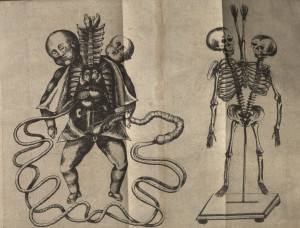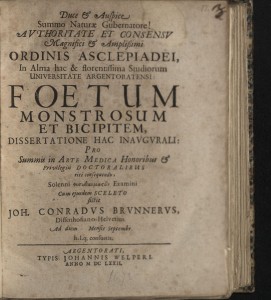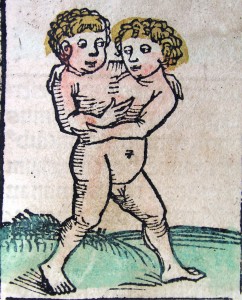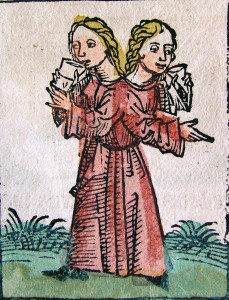This post is part of an ongoing series featuring items from the newly acquired Julio Mario Santo Domingo Collection.
 Johann Conrad Brunner was a Swiss anatomist that is best known for his work with the pancreas and duodenum. This fold out plate displays both anatomical and skeletal conjoined twin fetuses, which is part of Brunner’s medical dissertation Foetum monstrosum et bicipitem from the University of Strasbourg published in 1692. The thesis is bound together with about fifteen other titles almost all of which deal with complications with childbirth.
Johann Conrad Brunner was a Swiss anatomist that is best known for his work with the pancreas and duodenum. This fold out plate displays both anatomical and skeletal conjoined twin fetuses, which is part of Brunner’s medical dissertation Foetum monstrosum et bicipitem from the University of Strasbourg published in 1692. The thesis is bound together with about fifteen other titles almost all of which deal with complications with childbirth.
 One of the earliest depictions of conjoined twins appear on ceramics in the Moche culture in Peru. The Nuremburg Chronicle, also known as the Liber Chronicarum is a well-known early printed book, published in 1493 which tells of the human history of the world as related in the Bible. It was one of the first successful books that integrated text and illustrations together and also contains two color illustrations of conjoined twins.
One of the earliest depictions of conjoined twins appear on ceramics in the Moche culture in Peru. The Nuremburg Chronicle, also known as the Liber Chronicarum is a well-known early printed book, published in 1493 which tells of the human history of the world as related in the Bible. It was one of the first successful books that integrated text and illustrations together and also contains two color illustrations of conjoined twins.
A dried specimen of conjoined twins can be found on display in an exhibit from the Warren Anatomical Museum, located at the Countway Library on the 5th floor. The text Foetum monstrosum et bicipitem dissertatione hac inaugurali … cum ejusdem sceleto sistit Joh. Conradus Brunnerus … Argentorati : Typis Johannis Welperi, Anno MDCLXXII [1672]. QM690 .B83 1672, can also be found at the Countway Library at the Harvard Medical School in Longwood.
Thanks to Alison Harris, Santo Domingo Project Manager and Joan Thomas, Rare Book Cataloger at Countway for contributing this post.


